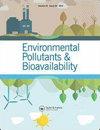高效去除水中镉离子的可回收磁性纳米复合材料:性能、机理和等温线研究
IF 3.2
4区 环境科学与生态学
Q2 BIOCHEMISTRY & MOLECULAR BIOLOGY
Environmental Pollutants and Bioavailability
Pub Date : 2023-01-04
DOI:10.1080/26395940.2022.2163922
引用次数: 2
摘要
本文章由计算机程序翻译,如有差异,请以英文原文为准。
Recyclable magnetic nanocomposites for efficient removal of cadmium ions from water: performance, mechanism and isotherm studies
ABSTRACT Herein, succinic acid functionalized Fe3O4@AMPA nanocomposite was synthesized as an effective adsorbent and used for the efficient removal of Cd(II) ions from aqueous media. Zeta potential, BET, TEM, TGA, and FTIR spectra were applied to characterize the Fe3O4@AMPA@SA nanocomposite. According to the BET analysis, the surface area of Fe3O4@AMPA@SA was found to be 43 m2/g. The influence of pH value, initial Cd(II) concentration, adsorbent dosage, temperature, and contact time on the adsorption process was achieved via the batch experiment method. The result showed that the optimal parameters were 6, 250 mg/L, 0.03 g/50 mL, 150 min, and 25°C, respectively. The experimental data fitted well to the Langmuir isotherm and the pseudo-first-order models. The maximum monolayer adsorption capacity of Cd(II) ions was 265 mg g−1. The adsorption mechanism of Cd(II) on magnetic nanocomposite is physical adsorption. The Fe3O4@AMPA@SA nanocomposite shows excellent reusability with a removal efficiency of 81.4% after three cycles. GRAPHICAL ABSTRACT
求助全文
通过发布文献求助,成功后即可免费获取论文全文。
去求助
来源期刊

Environmental Pollutants and Bioavailability
Chemical Engineering-Chemical Health and Safety
CiteScore
4.30
自引率
3.00%
发文量
47
审稿时长
13 weeks
期刊介绍:
Environmental Pollutants & Bioavailability is a peer-reviewed open access forum for insights on the chemical aspects of pollutants in the environment and biota, and their impacts on the uptake of the substances by living organisms.
Topics include the occurrence, distribution, transport, transformation, transfer, fate, and effects of environmental pollutants, as well as their impact on living organisms. Substances of interests include heavy metals, persistent organic pollutants, and emerging contaminants, such as engineered nanomaterials, as well as pharmaceuticals and personal-care products as pollutants.
 求助内容:
求助内容: 应助结果提醒方式:
应助结果提醒方式:


